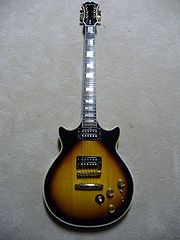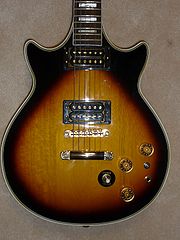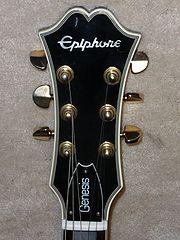
Epiphone Genesis
Encyclopedia



History
Three Genesis Series models (GN-CST, GN-DLX, GN-STD) first appeared in the 1979 Epiphone catalog and were produced in Taiwan until 1981. The 1980 price list indicates two additional Genesis Series models were offered briefly; The GN student model, and the GN-BA bass. All models of the Genesis (except the bass) shipped with black open-coil humbucker pickups with three height-adjustment screws, and not plated pickup covers with two height-adjustment screws as shown in the Epiphone specification sheets. It is not known whether the student model guitar "The GN" went into production; no known examples have been identified. It is rumored that Genesis guitars were made in Japan, but this is unsubstantiated. Gibson states that Genesis guitars were made in Taiwan.Construction
All models featured a solid mahoganyMahogany
The name mahogany is used when referring to numerous varieties of dark-colored hardwood. It is a native American word originally used for the wood of the species Swietenia mahagoni, known as West Indian or Cuban mahogany....
body, solid mahogany set neck, rosewood fretboard, two humbucker
Humbucker
A humbucker is a type of electric guitar pickup, first patented by Seth Lover and the Gibson company, that uses two coils, both generating string signal. Humbuckers have higher output than a single coil pickup since both coils are connected in series...
pickups, two volume controls, one master tone control, and a DPDT switch used for coil tapping
Coil tapping
Coil tapping is tapping into the inner coil of a single coil pickup to get a lower output/vintage tone . It is often confused with coil splitting, which is switching off one of the coils of a humbucker, giving the pickup a single coil tone....
.
The Genesis also featured an elongated headstock with 3 + 3 tuners, 22 frets, a front-mounted output jack, a Tune-o-matic
Tune-o-matic
Tune-o-matic is a name of fixed bridge design for electric guitars. It was designed by Ted McCarty and introduced in the Gibson Les Paul Custom guitar in 1954. In 1955, it was used on the Gibson Les Paul Gold Top...
bridge, and stop tailpiece.
Models
The Genesis was available in three models: the Standard had an unbound fretboard with dot inlays, single-ply binding on the body front and chrome hardware; the Deluxe had single-ply binding on the neck and headstock, double-ply binding on the body front and rear, chrome hardware and crown (trapezoid) inlays; the Custom had double binding on the neck, triple binding on the headstock, quadruple binding on the body, rectangular block fretboard inlays and gold plated hardware.Finishes
The Deluxe and Custom models were available in ebony (EB) and dark sunburst (DS) only.The Standard model was available in ebony and wine red (WR).
In the July 1, 1980 catalog, the Standard model became available in dark sunburst, and an entry-level The Genesis model and 4-string Genesis Bass guitar were offered.
SUGGESTED RETAIL PRICES:
January 15 & June 1, 1979
Standard: GN-STD, EB, WR $299.95
Deluxe: GN-DLX, EB, DS $349.95
Custom: GN-CST, EB, DS $399.95
January 7, 1980
Standard: GN-STD, EB, WR $329.95
Deluxe: GN-DLX, EB, DS $379.95
Custom: GN-CST, EB, DS $429.95
July 1, 1980
The Genesis: The-GN, EB, WR $279.95
Standard: GN-STD, EB, DS $329.95
Deluxe: GN-DLX, EB, DS $379.95
Custom: GN-CST, EB, DS $429.95
Bass: GN-BA, EB $349.95

